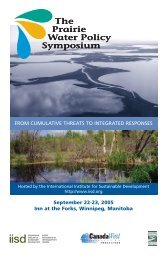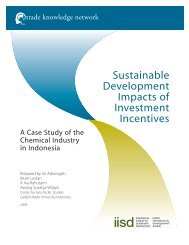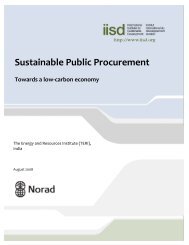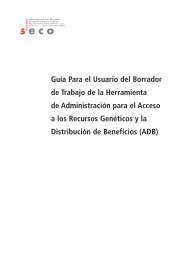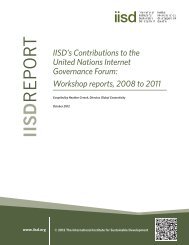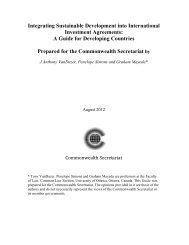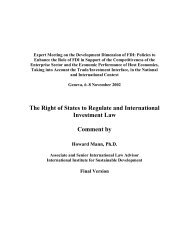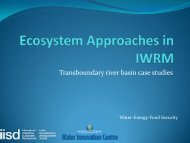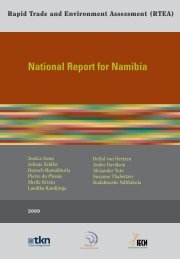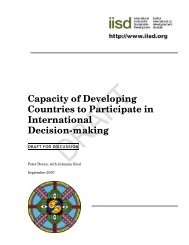Earthenterprise Tool Kit - International Institute for Sustainable ...
Earthenterprise Tool Kit - International Institute for Sustainable ...
Earthenterprise Tool Kit - International Institute for Sustainable ...
Create successful ePaper yourself
Turn your PDF publications into a flip-book with our unique Google optimized e-Paper software.
EarthEnterprise <strong>Tool</strong> <strong>Kit</strong><br />
Among the major international agreements driving technologies,now or in the<br />
future, are:<br />
Montreal Protocol on Ozone Depleting Substances<br />
Adopted by 25 countries in 1987, the Protocol has been amended twice and<br />
ratified by 127 parties. It calls <strong>for</strong> the complete phase out of fully halogenated<br />
chemical emissions by the end of 1995. Emissions of halons, a chemical used in<br />
fire extinguishers, were banned in 1993.The Protocol is undoubtedly the most<br />
advanced international agreement and has been implemented by national<br />
legislation in dozens of signatory countries.<br />
It has spawned a flurry of business activity in CFC recycling equipment and<br />
services, alternative refrigeration and air conditioning technologies, substitute<br />
chemicals, and new cleaning processes <strong>for</strong> electronic equipment. Halozone<br />
Recycling Inc. has capitalized on the Montreal Protocol with its “Blue Bottle”<strong>for</strong><br />
capturing refrigerants used in household refrigeration, and in residential and<br />
automotive air conditioning. A case study on Halozone, describing how the<br />
Blue Bottle was developed, financed and marketed appears on pages 64-69.<br />
Framework Convention on Climate Change<br />
There is growing concern that increasing emissions of greenhouse gases<br />
(GHGs), including carbon dioxide, will augment the natural greenhouse effect<br />
on the Earth’s atmosphere, and trigger climate change. Among the probable<br />
consequences: flooding of low-lying areas, drought, and more severe weather<br />
patterns. Energy consumption is the principal human activity that produces<br />
GHGs.<br />
The Climate Convention became law on March 21, 1994, after being ratified by<br />
50 countries. Many industrial nations are beginning to make commitments to<br />
reduce GHG emissions to 1990 levels. Business opportunities are thus growing<br />
in all fields related to energy efficiency. Developing, introducing, and globally<br />
disseminating these technologies and practices will require new financing,<br />
communication, and management strategies. The sectors most likely to be<br />
influenced and some of the new technologies that may be required are shown<br />
on pages 52-54.<br />
Convention on Biological Diversity<br />
In addition to helping feed and clothe us, biological resources provide shelter,<br />
fuel and medications. Millions of the Earth’s species are still unidentified, and<br />
the usefulness of many others has never been assessed. The ecosystems that<br />
house these species are being eroded by human activity. This Convention aims<br />
to conserve biological diversity and to make sustainable and equitable use of its<br />
components. Nations that sign the Convention agree to rehabilitate and protect<br />
46<br />
INTERNATIONAL INSTITUTE FOR SUSTAINABLE DEVELOPMENT



